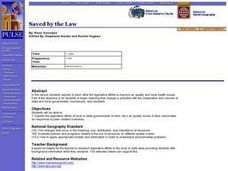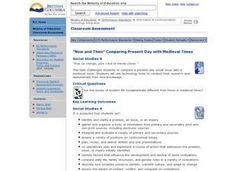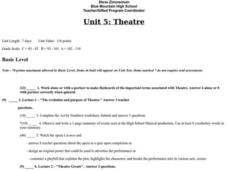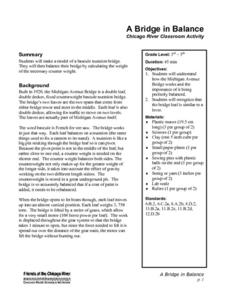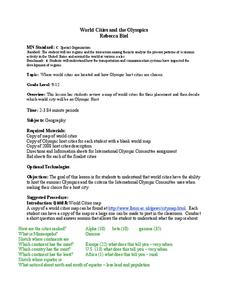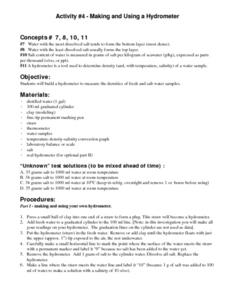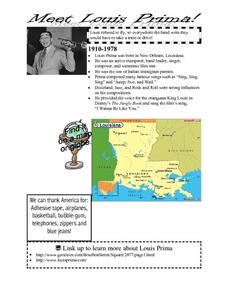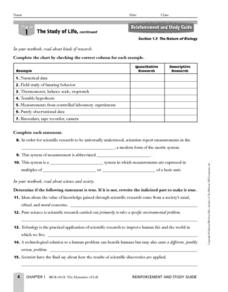Curated OER
Map Readng And Giving Directions
Learners read a story to create the context for the lesson. Then they are given or create a community map. Then students use the scenario of being lost in order to role play giving directions to a partner to find a destination. The...
Curated OER
The Art of the Puerto Rican People
Students study Taino Art and identify their crafts and stone carvings. They read the life of Campeche as presented and discuss with their teacher the economic and political situation of Puerto Rico in the eighteenth century and how...
Curated OER
Work
Ninth graders determine when work is being done on an object. They define work and calculate work for several examples. They define and give examples of force and distance and define power and calculate power. They determine the...
Curated OER
Introduction To Acrylic Painting and the Work of Wayne Thiebaud
Seventh graders explore the basics of composition, acrylic painting techniques, and color theory, examine works of the American painter Wayne Thiebaud, and create still lifes using three pieces of candy.
Curated OER
Graphing
Fifth graders practice using math graphs. In this graphing lesson, 5th graders work in groups to develop a topic of their own to represent as a graph. Students collect data and construct a graph for the lesson.
Curated OER
Saved by the Law
Students explain the legislative efforts of local or state governments on their city's air quality issues to their classmates as responses to peer-created scenarios. They determine that change is possible with the cooperation and...
Curated OER
"Now and Then" Comparing Present Day with Medieval Times
Eighth graders compare a present-day social issue with a medieval issue. They use technology tools to conduct their research and demonstrate their new knowledge. Students present their findings to the class in the form of a PowerPoint.
Curated OER
To Kill a Mockingbird
Learners participate in a layered curriculum unit in order to give them opportunities to master objectives. Students pick the activities and this allows a differentiated lesson to occur with many opportunities for assessment.
Curated OER
Unit 3 Cell Structures: Cell Theory & Organelles
Students examine cell structures in depth. They decide what grade they want to work for and do the assignments for that grade. They complete various assignments on cell theory and organelles.
Curated OER
Unit 5 DNA & Protein Synthesis
Students study and examine DNA and protein synthesis. Students decide what grade they want and complete only those assignment's. There are no objectives listed for this lesson plan.
Curated OER
Architecture
High schoolers use the glossary/dictionary and a partner to make flashcards of the important architectural terms and their definitions. Study them, present them to the teacher, and answer 5 correctly. This activity is part of a layered...
Curated OER
Theatre
Learners identify and create flashcards of important key terms as related to theatre. Students observe and write a 1-page summary of events seen at the High School Musical production using at least 8 vocabulary words in your summary....
Curated OER
Spanish 2 Chapter 4
Students participate in a layered curriculum lesson with activities like the following: Students design a 15 slide power point presentation using vocabulary in sentences that is in Spanish. They make a high quality brochure for Spanish...
Curated OER
The Value of Respect
Students participate in discussions and listen to audio programs about giving and receiving respect. They identify disrespectful behavior and role play ways to promote respect in their own lives. They also examine the relationship...
Curated OER
A Bridge in Balance
Students explore how the Michigan Avenue Bridge works and the
importance of it being perfectly balanced. They make a model of a bascule trunnion bridge and balance their bridge by calculating the weight
of the necessary counter weight.
Curated OER
Genetics
Students explain the difference between dominant and recessive genes, identify what causes differences in the traits of parents and their offspring, and explain how sex is determined. They will also improve their reading and...
Curated OER
World Cities and the Olympics
High schoolers examine the various cities in which Olympics have been held. Using a map, they describe the reasons why those cities were chosen and choose their own city for the Olympics and state the reasons why. They examine...
Curated OER
work in pairs for the activities of this lesson which include researching and identifying butterflies, writing, and a brief oral presentation.
Students explore the concepts of rdioactive decay and dating. They generate a radioactive decay table, use their data to plot a decay graph, develop the concept of half-life, and then use the graph to find the age of a mummified seal in...
Curated OER
Making and Using a Hydrometer
Students build a hydrometer to measure the densities of fresh and salt water samples. They record the water temperature and density and use the temperature, density, and salinity conversion graph to locate the salinity. Finally,...
Curated OER
Meet Louis Prima!
Students discover the difference in major and minor tonality after a brief introduction to Louis Prima. They discuss swing dancing and Louis Prima's role in the "Jungle Book" as the character King Louis. Students listen to the song...
Curated OER
Black Hawk Island Hike
Students explore Wisconsin's natural and cultural history through hands-on exploration of Upham Woods. They are shown the basic paddling skills and they work in teams to paddle across the river on barge. Students describe cultural...
Curated OER
The Study of Life
In this scientific research worksheet, students will complete a chart by determining if the statements given are examples of quantitative research or descriptive research. Then students will fill in the blank of 8 statements about the...
Curated OER
Ferns and Gymnosperms
In this plant worksheet, students review the different characteristics of ferns and gymnosperms. This worksheet has 12 fill in the blank questions.
Curated OER
Novel Response "The Night of The Twisters"
In this language arts instructional activity, learners graph interest in each chapter that is read in the book Night of The Twisters. They use the graph to analyze class opinion of the book.





